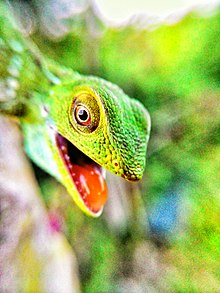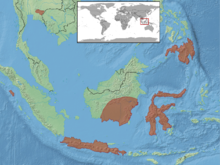
Calotes is a genus of lizards in the draconine clade of the family Agamidae. The genus contains 29 species. Some species are known as forest lizards, others as "bloodsuckers" due to their red heads, and yet others as garden lizards. The genus name Calotes has been derived from the Greek word Καλότης (Kalótës), meaning ‘beauty’, referring to the beautiful pattern of this genus.

Salea is a genus of arboreal, slow-moving, diurnal, insectivorous, egg-laying agamid lizards endemic to the Western Ghats of South India. It has two species, each inhabiting very high mountainous tracts of the Western Ghats in the Shola forest ecosystems.

Hardwicke's bloodsucker is an agamid lizard and found in South Asia.

Bronchocela cristatella, also known as the green crested lizard, is a species of agamid lizard endemic to Southeast Asia.

Calotes calotes, the common green forest lizard, is an agamid lizard found in the forests of the Western Ghats and the Shevaroy Hills in India, and Sri Lanka.

Monilesaurus ellioti, also known commonly as Elliot's forest lizard, is a species of arboreal, diurnal, lizard in the family Agamidae. The species is endemic to the Western Ghats, India.

Calotes emma, commonly known as the forest garden lizard or Emma Gray's forest lizard, is a species of lizard in the family Agamidae. The species is native to China, South Asia, and Southeast Asia. There are two recognized subspecies.

Calotes jerdoni, commonly known as the Indo-Chinese forest lizard or Jerdon's forest lizard, is a species of lizard in the family Agamidae. The species is endemic to China and South Asia.

Calotes maria, called commonly the Khasi Hills forest lizard or Assam garden lizard, is a species of lizard in the family Agamidae. The species is endemic to South Asia.

Calotes mystaceus, the Indo-Chinese forest lizard or blue crested lizard, is an agamid lizard found in China, South Asia and Southeast Asia.
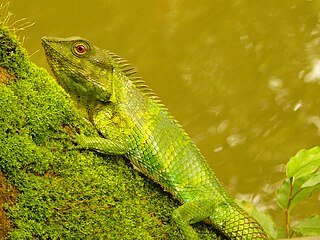
Calotes nemoricola, the Nilgiri forest lizard, is an agamid lizard found in the Western Ghats of India.
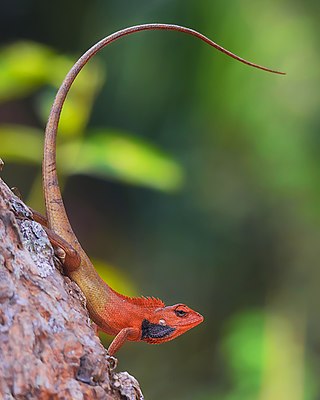
The oriental garden lizard, also called the eastern garden lizard, Indian garden lizard, common garden lizard, bloodsucker or changeable lizard, is an agamid lizard found widely distributed in Indo-Malaya. It has also been introduced in many other parts of the world.
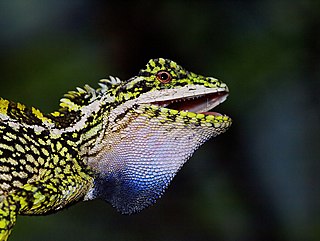
The variegated mountain lizard or Himalayan dragon is an agamid lizard found in northern India, Bhutan, and Nepal.

The peninsular rock agama or South Indian rock agama is a common species of agama found on rocky hills in south India. An allied species, Psammophilus blanfordanus, is found in the Eastern Ghats, but north of the range of this species.

Salea horsfieldii, commonly known as Horsfield's spiny lizard or the Nilgiri salea, is a species of lizard in the family Agamidae. The species is endemic to the Nilgiri Hills of India.

Boiga andamanensis, known commonly as the Andaman cat snake, is a species of rear-fanged snake in the family Colubridae. The species is endemic to the Andaman Islands.
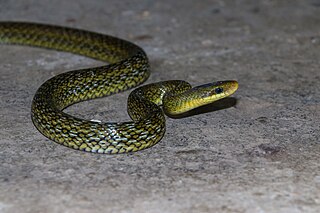
Elaphe hodgsoni, also known commonly as Hodgson's rat snake and the Himalayan trinket snake, is a species of snake in the family Colubridae. The species is native to parts of Asia around the Himalayas.

Boyd's forest dragon is a species of arboreal lizard in the family Agamidae. The species is native to rainforests and their margins in the Wet Tropics region of northern Queensland, Australia. It is the larger of the two species of Lophosaurus found in Australia. Another species, the southern angle-headed dragon, L. spinipes, is found in southern Queensland and northern New South Wales.
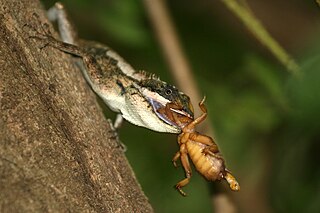
Calotes ceylonensis, commonly known as the painted-lipped lizard or the Ceylon bloodsucker, is a species of lizard in the family Agamidae. It is one of four Calotes species endemic to Sri Lanka.
Calotes bhutanensis is a species of lizard in the family Agamidae. It is endemic to the mountainous regions of Bhutan.
